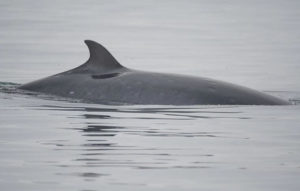In July we saw some species that aren’t necessarily rare in the Sitka Sound area, but they are rarer in terms of our sightings of them.
 First up: The Northern Minke whale (Balaenoptera acutorostrata). We have only seen one so far this season. Comparably, last year we saw about 6-7 by this time. Minke whales are the smallest baleen whale in North American waters, measuring roughly 35 ft long and up to 20,000 pounds, or about 10 tons. They are also found in most of the other oceans around the world. Their name derives from an inexperienced Norwegian whale spotter by the name of Meincke, who thought the minke he sighted was a blue whale. These whales have a hooked-shaped dorsal fin, are dark grey with a whitish underside. They have a pale V-shaped stripe on their back above the flippers. The Northern Minkes also have a distinguished white band on their pectoral fins. This feature differs in comparison to the Dwarf Minke and Antarctic Minke subspecies. Minke whales feed on small fish, plankton, and crustaceans by side-lunging. When observing one, the bushy spout will not exceed 10ft high, you will likely see it come out nose-first, and you won’t see the fluke like you can when a humpback whale dives.
First up: The Northern Minke whale (Balaenoptera acutorostrata). We have only seen one so far this season. Comparably, last year we saw about 6-7 by this time. Minke whales are the smallest baleen whale in North American waters, measuring roughly 35 ft long and up to 20,000 pounds, or about 10 tons. They are also found in most of the other oceans around the world. Their name derives from an inexperienced Norwegian whale spotter by the name of Meincke, who thought the minke he sighted was a blue whale. These whales have a hooked-shaped dorsal fin, are dark grey with a whitish underside. They have a pale V-shaped stripe on their back above the flippers. The Northern Minkes also have a distinguished white band on their pectoral fins. This feature differs in comparison to the Dwarf Minke and Antarctic Minke subspecies. Minke whales feed on small fish, plankton, and crustaceans by side-lunging. When observing one, the bushy spout will not exceed 10ft high, you will likely see it come out nose-first, and you won’t see the fluke like you can when a humpback whale dives.
(source: https://www.fisheries.noaa.gov/species/minke-whale)
Red-necked Phalaropes
 These shorebirds have been plentiful out between Vitzskari Rocks and Saint Lazaria over the past week or so. They are very quick and fast, so it was hard for us to initially identify them as Red-necked Phalaropes! Thanks to the Sitka Birds Facebook and email network, we were able to have it confirmed. The ones we have been seeing, however, are not in the plumage displaying the “red neck.” Therefore, they could be immature non-breeding ones, or females that are no longer displaying their red breeding plumage from earlier in the year in the Arctic, which is where they breed. An interesting fact about these birds is that they play reverse sex roles: females are generally larger and display more color than the males and are the sex that lead the mate selection, as the males incubate the eggs.
These shorebirds have been plentiful out between Vitzskari Rocks and Saint Lazaria over the past week or so. They are very quick and fast, so it was hard for us to initially identify them as Red-necked Phalaropes! Thanks to the Sitka Birds Facebook and email network, we were able to have it confirmed. The ones we have been seeing, however, are not in the plumage displaying the “red neck.” Therefore, they could be immature non-breeding ones, or females that are no longer displaying their red breeding plumage from earlier in the year in the Arctic, which is where they breed. An interesting fact about these birds is that they play reverse sex roles: females are generally larger and display more color than the males and are the sex that lead the mate selection, as the males incubate the eggs.
These little birds are dabbers, feeding on the surface for aquatic invertebrates. We have been seeing them in pieces of kelp floating on the surface, which is common in the later summer as storms, tides, and winds, detach some of the kelp from its holdfast.
https://www.allaboutbirds.org/guide/Red-necked_Phalarope/overview